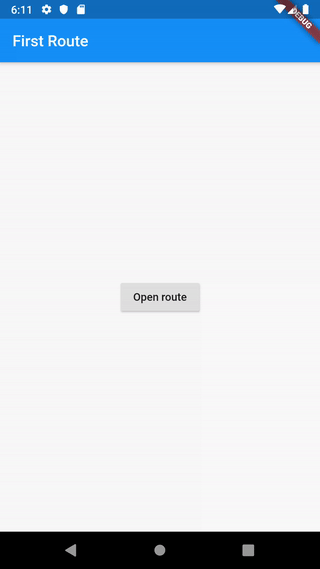
플루터 공식문서의 중첩 네비게이터 활용 사례에 대해 일부 내용을 정리해 보았다.
중첩 네비게이터 앱은 둘 이상의 네비게이터를 사용할 수 있음. 하나의 네비게이터를 다른 네비게이터 아래에 중첩하여 탭 내비게이션 등을 작성할 수 있음.
중첩 네비게이터 사용 예제
import 'package:flutter/material.dart';// ...void main() => runApp(new MyApp());// ...class MyApp extends StatelessWidget {
@override
Widget build(BuildContext context) {
return MaterialApp(
title: 'Flutter Code Sample for Navigator',
// MaterialApp contains our top-level Navigator
initialRoute: '/',
routes: {
'/': (BuildContext context) => HomePage(),
'/signup': (BuildContext context) => SignUpPage(),
},
);
}
}class HomePage extends StatelessWidget {
@override
Widget build(BuildContext context) {
return DefaultTextStyle(
style: Theme.of(context).textTheme.display1,
child: Container(
color: Colors.white,
alignment: Alignment.center,
child: Text('Home Page'),
),
);
}
}class CollectPersonalInfoPage extends StatelessWidget {
@override
Widget build(BuildContext context) {
return DefaultTextStyle(
style: Theme.of(context).textTheme.display1,
child: GestureDetector(
onTap: () {
// This moves from the personal info page to the credentials page,
// replacing this page with that one.
Navigator.of(context)
.pushReplacementNamed('signup/choose_credentials');
},
child: Container(
color: Colors.lightBlue,
alignment: Alignment.center,
child: Text('Collect Personal Info Page'),
),
),
);
}
}class ChooseCredentialsPage extends StatelessWidget {
const ChooseCredentialsPage({
this.onSignupComplete,
}); final VoidCallback onSignupComplete; @override
Widget build(BuildContext context) {
return GestureDetector(
onTap: onSignupComplete,
child: DefaultTextStyle(
style: Theme.of(context).textTheme.display1,
child: Container(
color: Colors.pinkAccent,
alignment: Alignment.center,
child: Text('Choose Credentials Page'),
),
),
);
}
}class SignUpPage extends StatelessWidget {
@override
Widget build(BuildContext context) {
// SignUpPage builds its own Navigator which ends up being a nested
// Navigator in our app.
return Navigator(
initialRoute: 'signup/personal_info',
onGenerateRoute: (RouteSettings settings) {
WidgetBuilder builder;
switch (settings.name) {
case 'signup/personal_info':
// Assume CollectPersonalInfoPage collects personal info and then
// navigates to 'signup/choose_credentials'.
builder = (BuildContext _) => CollectPersonalInfoPage();
break;
case 'signup/choose_credentials':
// Assume ChooseCredentialsPage collects new credentials and then
// invokes 'onSignupComplete()'.
builder = (BuildContext _) => ChooseCredentialsPage(
onSignupComplete: () {
// Referencing Navigator.of(context) from here refers to the
// top level Navigator because SignUpPage is above the
// nested Navigator that it created. Therefore, this pop()
// will pop the entire "sign up" journey and return to the
// "/" route, AKA HomePage.
Navigator.of(context).pop();
},
);
break;
default:
throw Exception('Invalid route: ${settings.name}');
}
return MaterialPageRoute(builder: builder, settings: settings);
},
);
}
}새로운 화면으로 이동하고, 되돌아오기


대부분의 앱은 여러 종류의 정보를 보여주기 위해 여러 화면을 갖고 있dma. 예를 들어, 어떤 앱이 상품 목록을 보여주는 화면을 갖고 있다고 한다면, 사용자가 한 상품을 선택했을 때 새로운 화면에서 해당 상품의 상세 정보를 볼 수 있음. 용어: Flutter에서 screen 과 page 는 route 로 불림.
Route는 Android의 Activity, iOS의 ViewController와 동일함. Flutter에서는 Route 역시 위젯임.
새로운 route로 Navigator를 사용하여 아래와 같은 단계로 진행하여 이동함.
- 두 개의 route를 생성합니다.
- Navigator.push()를 사용하여 두 번째 route로 전환합니다.
- Navigator.pop()을 사용하여 첫 번째 route로 되돌아 옵니다.
- 두 개의 route를 생성합니다. 우선 두 개의 route를 생성함. 예제에서는 첫 번째 route의 버튼을 누르면 두 번째 route로 화면 전환되며, 두 번째 route의 버튼을 누르면 첫 번째 route로 되돌아 옴.
class FirstRoute extends StatelessWidget {
@override
Widget build(BuildContext context) {
return Scaffold(
appBar: AppBar(
title: Text('First Route'),
),
body: Center(
child: RaisedButton(
child: Text('Open route'),
onPressed: () {
// 눌렀을 때 두 번째 route로 이동합니다.
},
),
),
);
}
}class SecondRoute extends StatelessWidget {
@override
Widget build(BuildContext context) {
return Scaffold(
appBar: AppBar(
title: Text("Second Route"),
),
body: Center(
child: RaisedButton(
onPressed: () {
// 눌렀을 때 첫 번째 route로 되돌아 갑니다.
},
child: Text('Go back!'),
),
),
);
}
}- Navigator.push()를 사용하여 두 번째 route로 전환합니다. 새로운 route로 전환하기 위해 Navigator.push() 메서드를 사용함. push() 메서드는 Route를 Navigator에 의해 관리되는 route 스택에 추가함. Route는 직접 생성하거나, 새로운 route로 이동시 MaterialPageRoute를 사용할 수 있음.
// Within the `FirstRoute` widget
onPressed: () {
Navigator.push(
context,
MaterialPageRoute(builder: (context) => SecondRoute()),
);
}- Navigator.pop()을 사용하여 첫 번째 route로 되돌아 옴. 두 번째 route를 닫고 이전 route로 Navigator.pop() 메서드를 사용여 되돌아감. pop() 메서드는 Navigator에 의해 관리되는 route 스택에서 현재 Route를 제거함.
// Within the SecondRoute widget
onPressed: () {
Navigator.pop(context);
}완성된 예제
content_copy
import 'package:flutter/material.dart';void main() {
runApp(MaterialApp(
title: 'Navigation Basics',
home: FirstRoute(),
));
}class FirstRoute extends StatelessWidget {
@override
Widget build(BuildContext context) {
return Scaffold(
appBar: AppBar(
title: Text('First Route'),
),
body: Center(
child: RaisedButton(
child: Text('Open route'),
onPressed: () {
Navigator.push(
context,
MaterialPageRoute(builder: (context) => SecondRoute()),
);
},
),
),
);
}
}class SecondRoute extends StatelessWidget {
@override
Widget build(BuildContext context) {
return Scaffold(
appBar: AppBar(
title: Text("Second Route"),
),
body: Center(
child: RaisedButton(
onPressed: () {
Navigator.pop(context);
},
child: Text('Go back!'),
),
),
);
}
}'flutter' 카테고리의 다른 글
| [Flutter] flutter 프로젝트 새로 생성하기 (0) | 2021.11.16 |
|---|---|
| [Flutter] Flutter Navigator 사용법 (5) (0) | 2021.11.16 |
| [Flutter] Flutter Navigator 사용법 (4) (0) | 2021.11.16 |
| [Flutter] Flutter Navigator 사용법(3) (0) | 2021.11.16 |
| [Flutter] Flutter Assets와 image추가하기 (0) | 2021.11.16 |



